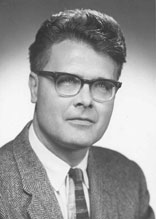 E. James Ferguson, author of the classic The Power of the Purse: A History of American Public Finance, 1776-1790, died at his home in Maryland on September 11, 2002. He is survived by his wife of 60 years, Louise, his son Bruce, and two grandchildren.
E. James Ferguson, author of the classic The Power of the Purse: A History of American Public Finance, 1776-1790, died at his home in Maryland on September 11, 2002. He is survived by his wife of 60 years, Louise, his son Bruce, and two grandchildren.
Jim Ferguson published his masterpiece at a time when Americans, flushed with pride at having saved the world from totalitarianism and armored intellectually for the Cold War, wanted their history as a pageant, with none of the complicated questions raised by earlier studies in the progressive tradition launched by Charles Beard. Born in Provo, Utah, in 1917, Ferguson earned a BA and MS at the University of Washington. Ferguson served from 1941 to 1945 as a technical sergeant in the U.S. Army Signal Corps, and then became an instructor at the University of Maryland beginning in 1947.
He completed his PhD in 1951, with Merrill Jensen of the University of Wisconsin-Madison supervising his thesis. It is not surprising therefore that Ferguson developed an intellectual integrity that continued to shine throughout his career. But Jim Ferguson also could never have been so foolish as to think that money simply did not matter. However glorious the era of America's Revolution and its subsequent consolidation in the Constitution, Professor Ferguson would tell students (including myself) in his graduate colloquium at City University of New York in 1966—always with a mischievous twinkle in his eye—someone must have paid the bills and surely he had gotten something for his money.
About five years before The Power of the Purse appeared in 1961, Robert Brown had published his iconoclastic analysis titled Charles Beard and the Constitution; barely five years after came Forrest McDonald's equally strident E Pluribus Unum. I recall teaching all three books in a graduate historiography course in the late 1960's. Those were heady days for a young scholar ready to lead a new anti-war generation on the militant path to truth, and I assumed that Ferguson's quiet style would not go over well, perhaps even become lost in the crossfire. As it turned out to the contrary, my students uniformly appreciated the subdued, even-handed, sober, crafted, thoroughly documented ways of Ferguson's book. They hoped to write like that someday and to a person they thought that paying the bills brought with it power and influence.
Winner of the AHA's John H. Dunning Prize for 1962, then awarded biennially for the best book in American history, some of the work's significant conclusions had been foreshadowed in four essays published in the 1950s in several of the profession's most prestigious journals: Mississippi Valley Historical Review (1951), William and Mary Quarterly (1953 and 1959), and Journal of Economic History (1954). The impact of The Power of the Purse continues: in spring 2001, forty years after its publication, it was on the required reading list for a seminar at Harvard Law School. The book is still formidable.
Following The Power of the Purse, there were significant changes in Jim Ferguson's career. After 17 years at the University of Maryland, interrupted only by visiting stints at Wisconsin, Illinois, and as an extension lecturer in Europe, Ferguson moved in 1964 to Queens College, where he taught, there and as a member of the CUNY graduate program, until he retired in 1984. Notwithstanding an ongoing string of articles in major scholarly journals, an array of book reviews, including all but one of the 27 volumes of the Hamilton Papers as they appeared over the years, and two textbooks of considerable synthetic power, the core of his new commitment was to preserving the historical record. In 1967 he published an edition of the selected writings of the Jeffersonian financier Albert Gallatin.
By this time he had embarked on what would occupy him for the remainder of his life: preparation and publication of a complete, annotated edition of the papers of Revolutionary War financier Robert Morris for the critical period from February 7, 1781 through October 30, 1784. Ferguson could not have foreseen the near-fatal accident, from which he recovered with great courage but not totally. Although the accident hastened his retirement from active teaching, he had been wise enough from the outset to recognize the enormity of the task he had undertaken and to recruit a staff to assist him in bringing the project—ultimately nine volumes—to completion. One of Ferguson's early graduate students, John Catanzariti, proved willing and able to start in the role of associate editor. By the time volume five appeared in 1980, Catanzariti and Ferguson were listed jointly as editors, while the last two volumes note him as editor emeritus and are edited jointly by Elizabeth M. Nuxoll and Mary A. Gallagher, both associated with the project for many years. They were all Ferguson's academic offspring, and it was sad indeed that ill health prevented him from attending the official celebration of the project's completion at a scholarly conference held at CUNY's new home in the spring of 2001.
Still, he had a long, good life and at the end he was at peace with himself and all he had done.
—Rudolph M. Bell, Rutgers University, New Brunswick
Tags: In Memoriam
Comment
Please read our commenting and letters policy before submitting.






